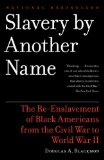Summary | Excerpt | Reviews | Readalikes | Genres & Themes | Author Bio
The Re-Enslavement of Black Americans from the Civil War to World War II

Critics' Opinion:
Readers' Opinion:
First Published:
Mar 2008, 480 pages
Paperback:
Jan 2009, 496 pages
The last desperate rallying calls of the Confederacy had been exhortations that a Union victory meant the political and economic subjugation of whites to their black slaves. In one of the final acts of the Confederate Congress, rebel legislators asserted that defeat would result in “the confiscation of the estates, which would be given to their former bondsmen.”
Already, forty thousand former slaves had been given title by Gen. William Tecumseh Sherman to 400,000 acres of rich plantation land in South Carolina early in 1865. It was unclear whether blacks would be able to retain any of the property, but rumor flared anew among blacks across the South the next year at Christmastime — the end of the annual crop season — that plantation land everywhere would soon be distributed among them. The U.S. Congress debated such a plan openly in 1867, as it drew up the statutes to govern Reconstruction in the southern states. And again as harvest time ended that year, word whipped through the countryside that blacks would soon have land. At one point the following year, in 1868, during a period of intense speculation among freed slaves that land was soon to be provided to them, many blacks purchased boundary markers to be prepared for the marking off of their forty-acre tracts.
Forty miles to the west of the Cottingham farm, in Greene County, hundreds of former slaves filed suit against white landowners in 1868 demanding that the former slave masters be compelled to pay wages earned during the prior season’s work. Whites responded by burning down the courthouse, and with it all 1,800 lawsuits filed by the freedmen.
Despite Bibb County’s remote location, far from any of the most famous military campaigns, the Civil War had not been a distant event. In the early months of fighting, Alabama industrialists realized that the market for iron sufficient for armaments would become lucrative in the South. In 1860 only Tredegar Iron Works, a vast industrial enterprise in Richmond, Virginia, driven by more than 450 slaves and nearly as many free laborers, could produce battle-ready cannon for the South. The Confederate government, almost from the moment of its creation, set out to spur additional capacity to make arms, particularly in Alabama, where a nascent iron and coal industry was already emerging and little fighting was likely to occur. During the war, a dozen or more new iron furnaces were put into blast in Alabama;12 by 1864, the state was pumping out four times more iron than any other southern state.
Excerpted from Slavery By Another Name by Douglas A. Blackmon Copyright © 2009 by Douglas A. Blackmon. Excerpted by permission of Anchor, a division of Random House, Inc. All rights reserved. No part of this excerpt may be reproduced or reprinted without permission in writing from the publisher.





The House on Biscayne Bay
by Chanel Cleeton
As death stalks a gothic mansion in Miami, the lives of two women intertwine as the past and present collide.

The Flower Sisters
by Michelle Collins Anderson
From the new Fannie Flagg of the Ozarks, a richly-woven story of family, forgiveness, and reinvention.

The Funeral Cryer by Wenyan Lu
Debut novelist Wenyan Lu brings us this witty yet profound story about one woman's midlife reawakening in contemporary rural China.
Your guide toexceptional books
BookBrowse seeks out and recommends the best in contemporary fiction and nonfiction—books that not only engage and entertain but also deepen our understanding of ourselves and the world around us.